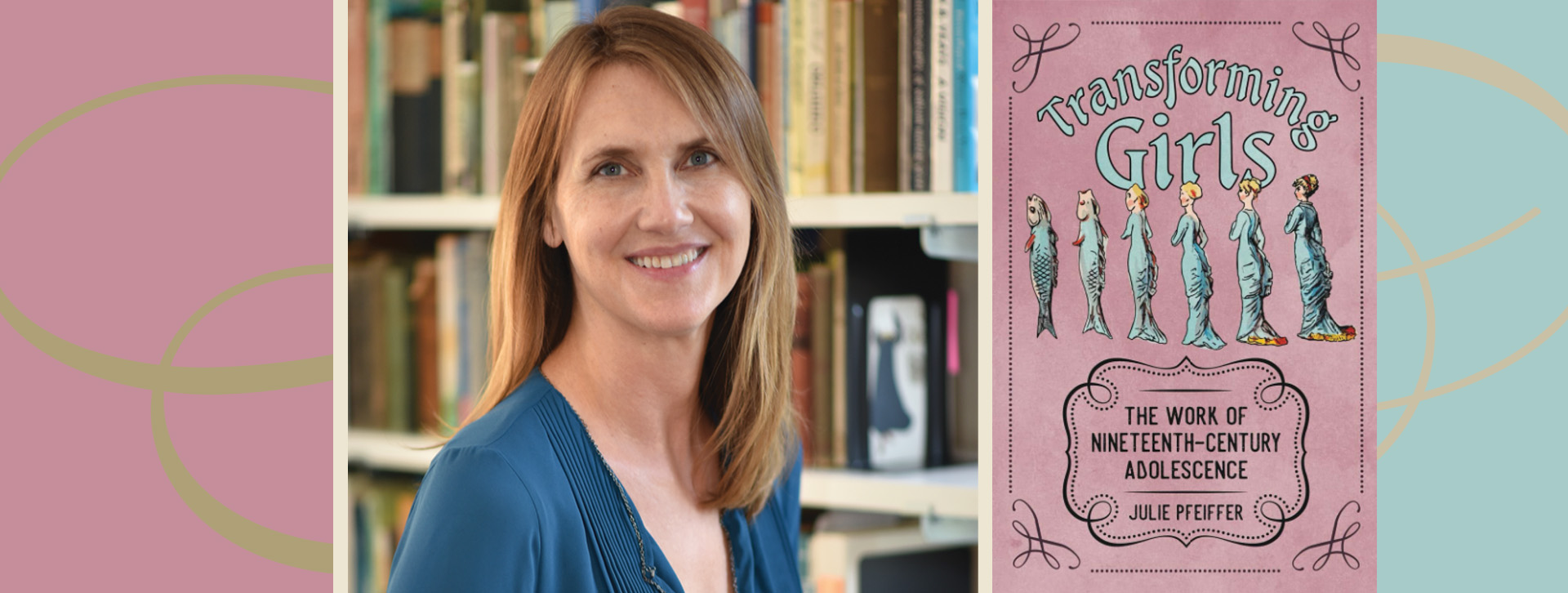GIRLHOOD REVISITED AND REIMAGINED
Julie Pfeiffer, professor of English and chair of the department of English and creative writing at Hollins, recently published her first book, Transforming Girls: The Work of Nineteenth-Century Adolescence. Released on October 15 by University Press of Mississippi, Transforming Girls analyzes a variety of since-forgotten mid-19th-century bestsellers that were aimed at adolescent girls in the United States and Germany. To commemorate the book’s publication, Pfeiffer spoke with Marin Harrington M.F.A. ’23 about researching and writing Transforming Girls, along with the continued importance of studying children’s literature.
What assumptions about adolescent girls’ literature from this era are you hoping to challenge or reevaluate with your book?
There’s a critical assumption in the United States that adolescent fiction didn’t develop until the 1970s. Yet there are all these books written in the mid-1800s that are explicitly about adolescent girls and that talk about adolescence as a time of difficult transition. I realized that, in fact, there were 19th-century American girls’ books about adolescence and we had just forgotten about them.
How did you end up rediscovering these American novels in the first place?
It actually started with my sabbatical as a Fulbright Senior Scholar at Johann-Wolfgang University in Frankfurt, Germany. I was studying German girls’ books and initially thought they were different from American ones because American girls’ books are family stories or they’re about younger girls, while these German books were about adolescents. I thought I might write a book about the contrast between American and German girls’ books until I actually started reading best-selling American girls’ books from the 1800s and noticed their similarities.
There was a strong German presence in the U.S. in the 19th century. There were German printing presses, and German books were translated into English and vice versa. A cross-cultural exchange happened that was oriented around the idea that there is such a thing as adolescent girlhood, and these books treated female adolescence as a creative, transformative space, whereas we currently view adolescence as a time of alienation and angst.
Since this idea of “creative transformation” is so central to these novels, could you talk about what that concept looks like in these books?
The teenage girls in these 19th-century books tend to be awkward. They’re kind of a mess, and they’re loved despite that. The girls feel embarrassed, but the adult women around them acknowledge that becoming a woman is not an inevitable, natural process, but a construction that’s hard work. These female role models provide girls with a supportive environment where it’s okay to make mistakes. Today we expect the ideal teenage girl to be charming, and if she’s not, that’s a problem that needs to be solved. One of my chapters is called “The Romance of Othermothering” and it talks about how mothering happens outside of heterosexual marriage in these books. Even though the protagonists are usually expected to find a husband as soon as possible, they are often mothered by single aunts or teachers, and the girls are mothering each other as peers who take care of each other. There’s a sense of completion that happens in these novels when a girl learns how to nurture other girls and women.
Even though you point out lots of positive messages that these books can send to young girls who are in the throes of adolescence, do you still think that these books have a place with contemporary audiences, considering they also hold problematic views on gender and race?
Transforming Girls really developed from a question I started asking maybe 20 years ago, which was: Why do I read, teach, and study these classic girls’ books that are so clearly sexist and also reinforce white privilege? I say in my book that I don’t necessarily recommend giving these books to teenagers. I write instead about using the positive aspects of these novels to imagine a different vision of adolescence and reframe our ideas about how to support teenagers. I do believe that the things we read when we’re young, before we have structures for intellectual critique in place, can become deeply internalized. We absorb certain ideologies and maybe spend the rest of our lives sorting out which of those ideologies we actually wanted to absorb and which we didn’t. I think part of the importance of studying children’s literature is thinking about the kind of conversations we want to have with children who are reading.
What have you found most powerful about being able to reexamine the books that you read as a child through this new scholarly outlook?
There is something powerful about this notion of celebrating girlhood and saying that yes, being an adolescent girl is an experience worth writing about. It’s a concept that has just really resonated with me and is a reason why I want to keep reading, teaching, and critiquing these books. Taking on the womanly identity your culture expects of you is a kind of invisible labor, and these girls’ books make that labor visible. Now we have the opportunity to think about what we’re choosing to do and what we’re not—and maybe redefine the grumpy adolescent girl as someone who’s actually working really hard to make herself into a new person.
Marin Harrington is a current creative writing M.F.A. student and marketing intern.

